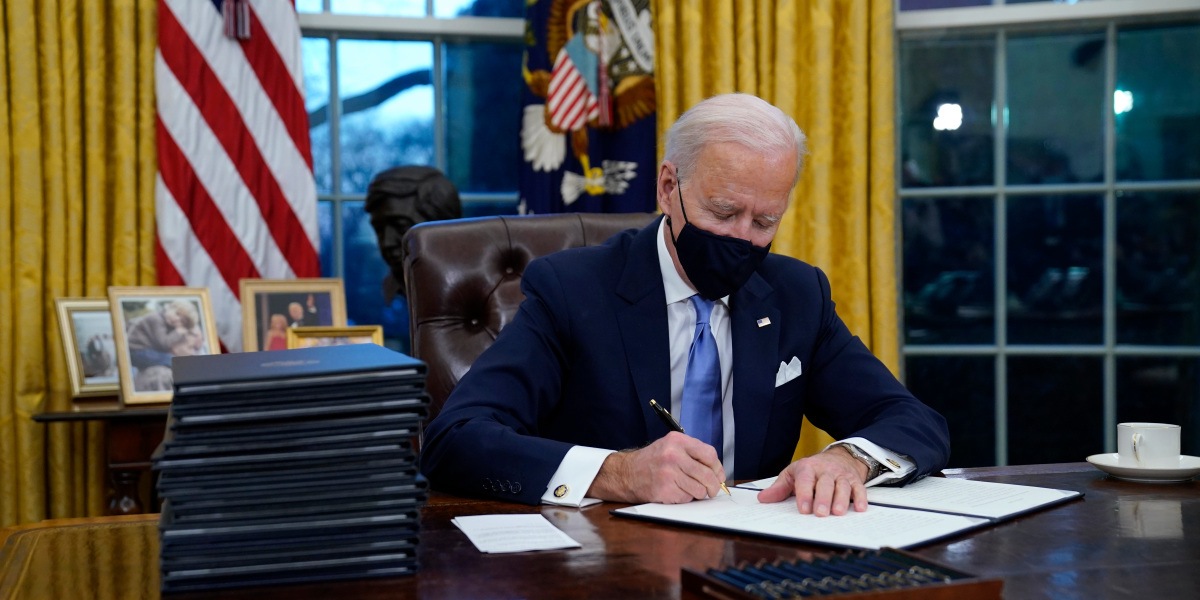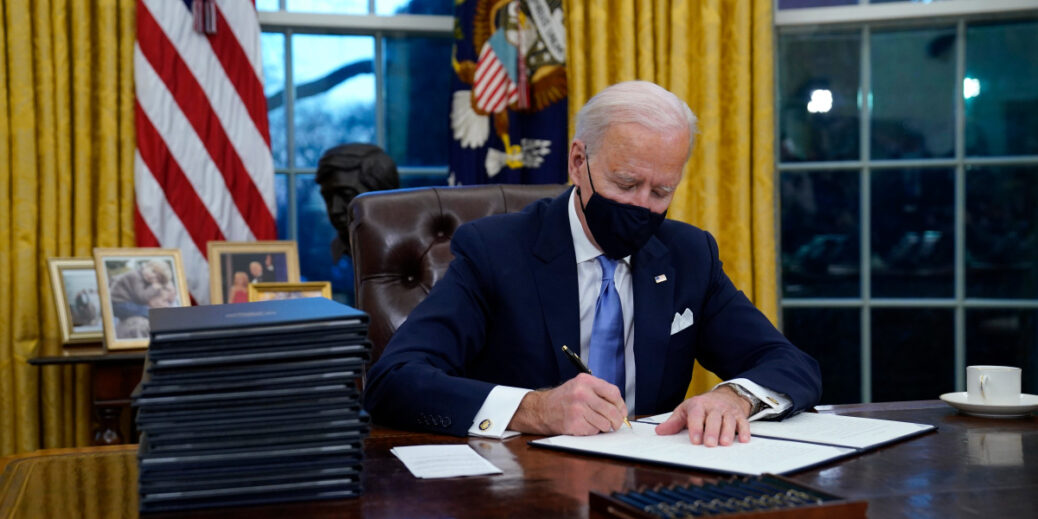
A flurry of executive orders is expected to take place over the next few days from the new US president as he takes residence in the White House. Here are the highlights of those he has signed so far.
The “100 day mask challenge”
Biden’s first order is part recommendation, part requirement: it requires people to wear masks on all federal property, and recommend that governors and local elected officials follow suit. The wording also attempts to turn masking, a vital public health recommendation that can help to stop the spread of covid-19, into a public challenge, calling for all Americans to stick to wearing masks for the next 100 days. —Abby Ohlheiser
Rejoining the Paris climate accords
Biden wasted little time setting a new tone on climate change, an issue he has pledged to make a centerpiece of his presidency. As promised throughout the campaign and after, Biden began the process of bringing the nation back into the Paris climate agreement on his first day in office.
Rejoining the Paris agreement, which will officially take a few more weeks, doesn’t create any new binding climate policies in itself. But it will require the US to submit revamped emissions targets before the UN climate conference later this year, as well as a plan for deep reductions by mid-century. The grand hope is that the world’s second largest emitter returning to the international fold will build more momentum behind the global goal of preventing 2 ̊C of warming. After four years under Trump, however, the US will need to repair extensive damage to its international relationships and achieve real progress on its domestic climate policies before it will be seen as a leader rather than laggard on the issue. —James Temple
Canceling Keystone
Biden also issued a sweeping executive order on climate change that directed federal agencies to begin reviewing, and where appropriate reversing, the Trump administration’s efforts to loosen or unravel dozens of energy and environmental policies.
It revoked the construction permit for the controversial Keystone XL Pipeline, which would transport crude oil from Canada to Illinois. In addition, it called on agencies to start the process of creating tighter rules on methane emissions from the oil and gas industry; enacting new vehicle fuel economy standards; setting stricter appliance- and building-efficiency standards; and establishing what’s known as a “social cost” of carbon, nitrous oxide & methane, determinations used to more accurately evaluate the cost and benefits of federal policies by incorporating the environmental effects of these greenhouses gases.
Separately, the order directs the Secretary of the Interior to review the Trump administration’s efforts to remove land from and allow oil and gas exploration on or near national monuments, including Bear Ears and Grand Staircase-Escalante. It also asks the department to halt and evaluate the environmental impacts of drilling plans in the Arctic National Wildlife Refuge.
The new administration plans to enact more aggressive action on climate change on Jan. 27, including signing an executive order that puts the issue at the forefront of domestic and national security policy, the Washington Post reported.
Each of these steps could provide greater regulatory certainty to states, companies and investors, and otherwise boost the markets for a variety of climate tech and clean energy industries. But accelerating US emissions cuts enough to meet the Paris goals – or to achieve Biden’s own targets of carbon-free electricity by 2035 and net-zero emissions economy-wide by 2050 – will require pushing stricter climate legislation through Congress. And it’s going to remain tricky to enact anything too ambitious with only a slim Democratic majority in the Senate.
Federal covid response
Following up on the recent announcement of a proposed $1.9 trillion covid relief and action plan, the president signed an order that will shift around some key positions within the federal government that will be crucial to the new administration’s pandemic response. Biden will be reinstating the Directorate for Global Health Security and Biodefense, which Obama created after the Ebola epidemic. Under Trump, the directorate’s staff—along with its work and general mission—were largely absorbed by other offices in the National Security Council. Biden has in the past, somewhat misleadingly implied that the office was completely eliminated. —Abby Ohlheiser
Rejoining the WHO
In the middle of a global pandemic, Trump began the process of formally withdrawing the US from the World Health Organization. Biden’s first-day order would halt that process. —Abby Ohlheiser
Changes to immigration rules
Biden plans to undo many of President Trump’s controversial immigration policies through a combination of executive orders and proposed legislation. Among the orders today, he has announced an end to the Muslim ban, halting construction of the US-Mexico border wall; preserving the Deferred Action for Childhood Arrivals program, or DACA; and revoking Trump’s order to exclude non-citizens from the census count. Other important changes that will go to Congress include new pathways to citizenship for 11 million immigrants without permanent legal status, and modernizing the immigration court system and clear current backlogs.—Eileen Guo
Extending a block on evictions
As we reported in December, thousands of eviction hearings are taking place by videoconference and phone call—a technological disparity that is often leading to people being forced out of their homes unfairly. Without further action, the CDC’s eviction moratorium, which was set to expire on January 31, meant tens of millions were at risk of losing their homes in the middle of a pandemic. An executive order from Biden extends the block through the end of March—at least for those who can prove they are unable to pay. —Eileen Guo
This story will be updated with more actions and executive orders as they are announced.




Recent Comments